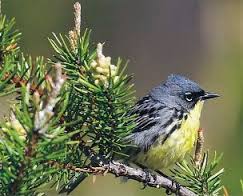What is the Kirtland’s Warbler? Part 2
Add Summary

Oct. 17, 2013
Jackie Hulina was a master's student in the Michigan State University's Center for Systems Integration and Sustainability.
How many of your teachers have told you that knowledge is the key to success?
That’s why when people started to notice that Kirtland’s warblers were declining – and fast – they realized the need to learn more about the bird.
 By the second half of the twentieth century, scientists and habitat managers knew enough about the Kirtland’s warbler breeding grounds to conduct a census to monitor changes in the population.
By the second half of the twentieth century, scientists and habitat managers knew enough about the Kirtland’s warbler breeding grounds to conduct a census to monitor changes in the population.
A failed attempt to establish a few small preserves in Michigan state forest areas in 1956 revealed that Kirtland’s warblers need a fairly large habitat – in fact populations thrive in habitats larger than 80 acres, though it’s still not clear why such a small bird needs such a large area. In the 1960s, we found evidence that Kirtland’s warblers need fire, since jack pine cones only release their seeds in extreme heat, and that cowbirds are detrimental to their survival.
Michigan Recipe for Kirtland’s Warblers:
- > 80 acres of dense, young jack pine forest
- Regular disturbance to regenerate forest habitat – i.e. fire or clear cutting/planting young jack pines
- Plenty of insects
- Cowbird removal
The first Kirtland’s Warbler Recovery Team was then established, in accordance with the Endangered Species Act of 1973.
Since then, management methods have included harvesting and replanting jack pines as well as removing cowbirds. Controlled burns would be the best way to regenerate habitat, but private landowners near the Huron-Manistee National Forest have been skeptical ever since the Mack Lake fire burned 25,000 acres of forest (only 210 acres were intended), 44 homes, and took one man’s life.
Overall, Kirtland’s warbler management methods have been highly successful. These successes have been attributed to an intensive education campaign and a high level of interagency cooperation, leading the recovery team to consider delisting the species in future years.
Just WHO is helping KW?
- Kirtland’s Warbler Recovery Team
- Michigan Department of Natural Resources
- U.S. Forest Service
- U.S. Fish and Wildlife Service
- Kirtland’s Community College
- Michigan Audubon Center
- Nature Conservancy
But wait – those habitat management methods sounds pretty intensive. Kirtland’s warblers are a conservation-reliant species, which means that they rely heavily on everything that habitat managers have been doing to create suitable habitat. What happens to the Kirtland’s warbler once government funding for habitat management is removed?
Now you have to think like a member of the Kirtland’s Warbler Recovery Team.
How do we provide long-term habitat management so that the species doesn’t return to



 Print
Print Email
Email





